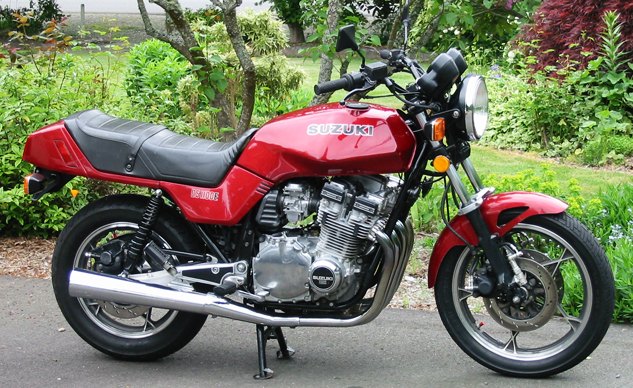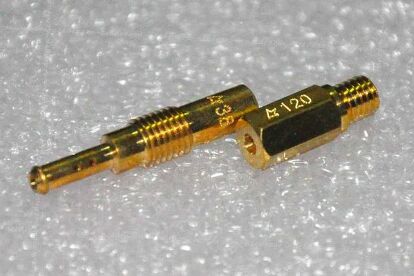Why Won't My Motorcycle Engine Rev To Redline?
Ask MO Anything: Feels like we're running out of gas.
Dear MOby,
I dragged home an ’82 Suzuki GS1100E from a friend of a friend’s basement a couple months ago. At first, it appeared way dusty and sad and I thought I was being taken. But after not all that much cleaning and polishing, it’s a really terrific looking old motorcycle nobody else has, and I’m really liking it.
I don’t know how long it had been sitting. There was no gas in the tank, but some terrible ex-petroleum semi-liquid did dribble out of the float bowl drains. I took the carbs apart and the jets were all actually totally plugged with dried-up residue. I took them to a local shop and had them cleaned in one of those ultrasonic tanks. Put in new spark plugs and air filter, and inspected all the intake area for leaks. Everything seems to be good, gas is flowing through the petcock, spark is good to all four cylinders. It’ll start up, idle, and run pretty okay up to 5,000 or so rpm – but past there, it spits back and runs rough and refuses to rev any farther. What’s the problem?
Revless in Seattle
Dear Revless,
Mickey Cohen of Mickey Cohen Motorsports and right-hand man Cyle Winkler tell us what’s often the malady in situations like this is that your main jets have actually been etched by the nasty old brew that sat in there, a sort of PTSD for carburetor brass parts. In the old days, it was a no-no to drill jets out because they’re much more than just brass plugs with holes in them; those holes are actually carefully shaped for smooth fluid flow.
The scars left behind by the old gas in those soft brass nozzles, especially if ethanol was the last fuel in there and especially if they were plugged solid, actually disrupts the smooth flow of gas through the carburetors and into the engine. MC suggests ordering up new jets, both main and pilot, and replacing the float valve needles and seats while you’re at it, since they’re also brass. Good luck!
Send your moto-related questions to AskMOAnything@motorcycle.com. If we can’t answer them, well, ahhh, hey, nobody’s perfect.
Recent Ask MOs:
Why Are My Brakes Still Mushy?
Why Is My Suzuki Spitting Oil?
What’s The Worst Thing You Can Do At A Motorcycle Track Day?
More by John Burns



































Comments
Join the conversation
Suggest you check for leaky carb boots: With the engine idling, spray a little carb cleaner around the rubber boots between the carbs and the head: If the engine revs up a little, you have a leak. That will cause lean running, poor vacuum and an inability to rev. If you have a leak, replace the boots and that will help.
I used to be a preacher leading the anti-ethanol crusade. Driven mad as a hatter by the inability (mine, and my mechanic's) to tune up my clunker, I had come to the conclusion that ethanol was the evil source of my torment. Solution: eliminate ethanol from the gasoline. How? One way is to buy ethanol free gasoline. $10 a gallon and available only at select and rarer than dodo birds gas stations that deliver only in metal containers. Not much of an option. Another way (you can now judge the madness) was to separate the ethanol from the gasoline. To that effect you add a cup of water to your 5 gallon fresh gasoline mix, stir well, and let sit overnight. Next morning you have a two phase separation. At the bottom, 1/2 gallon + 1 cup of (ethanol-water) mix, at the top gasoline and whatever dispersants and additives did not separate. You decant, et voila, you have 4 1/2 gallons of pure(r) gasoline. Problem is the octane level is now way lower. You have to add some octane enhancer. I used that mix and the garden tools ran fine, though the engines didn't seem to want to rev quite as fast as they used. You may say; ok, I can live with that as long as I can now store my bike without worrying about ethanol separating and etching its evil name in the plastic of my Ducati. However, that doesn't really solve the issue. As it turns out, alcohol only absorbs half of one percent of water from the air, and it holds its water well, meaning it won't separate just from that amount. The real issue is water condensation on the walls of the tank.Yes, yes, yes. The emptier the tank, the more air it contains. The wider the temperature and humidity swings, the more water collects on the tank walls, then slowly finds its way into your gasoline. And that quantity of water is much larger than any amount ethanol may have absorbed or contained. That amount of condensation water is enough to lead to phase separation when alcohol is present, and enough to form a water layer at the bottom of the tank on its own. To make a long story short: Storing your bike with less than a full tank is more likely to lead to your bike starting issues than the amount of ethanol. Now I'll let you go back to taking off that tank, cleaning it thoroughly and reinstalling it. But remember, if you will not use your bike for any significant amount of time, you're better off topping the tank than draining it (unless you can dry it inside, and fill it with nitrogen, and seal it tight).